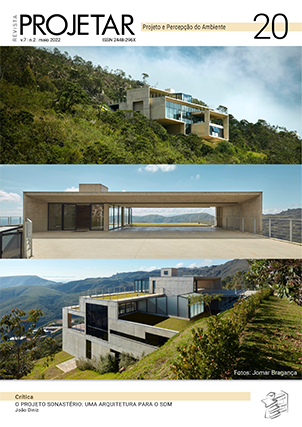OMNICHANNEL E RETAIL DESIGN
uma proposta metodológica
DOI:
https://doi.org/10.21680/2448-296X.2022v7n2ID27210Palavras-chave:
Omnichannel, Retail design, Ambiente de varejoResumo
O retail design é reconhecido como uma disciplina recente, iniciada por volta dos anos 1960, num setor que é caracterizado pela intuição, improvisação e imitação, como o varejo. O rápido avanço das tecnologias digitais tem proporcionado ciclos cada vez menores de mudança do comportamento do consumidor, e com isso, custos e riscos maiores para fabricantes e varejistas. Neste processo, que tem ocorrido de maneira muito sensível nos negócios e na sociedade, tem se questionado o papel da loja física e qual perfil, competências e habilidades do profissional que desenvolve esse novo ambiente de varejo. É neste contexto que o objetivo desta pesquisa consiste em configurar um modelo de desenvolvimento e aplicação de conceitos de omnichannel e retail design em ambientes de varejo. Com abordagem de pesquisa qualitativa relaciona-se os processos e fenômenos existentes na loja física e na área de omnichannel, retail design, marketing, branding, varejo, economia e administração. Por meio de pesquisa explicativa, há a investigação da relação entre a estratégia omnichannel, branding, retail design e experiência do cliente com a loja física. O modelo gerado utiliza das ferramentas, conceitos e processo encontrados durante a pesquisa, e tem como intenção orientar arquitetos e designers no desenvolvimento de projetos de ambientes de varejo contemporâneos alinhados à estratégia omnichannel que tragam resultados mais assertivos às empresas considerando seus planejamentos estratégicos.
Downloads
Referências
ALEXANDER, B.; CANO, M. Store of the future: Towards a (re)invention and (re)imagination of physical store space in an omnichannel context, Journal of Retailing and Consumer Services, Vol. 55, n. 101913, 2020. Disponível em: https://doi.org/10.1016/j.jretconser.2019.101913 . Acesso em 5 de julho 2020.
ARGAN, G. C. Projeto e destino. Trad. Marcos Bagno. 3. ed. São Paulo: Ática, 2004. p. 334.
ARBNOR, I.; BJERKE, B. Methodology for Creating Business Knowledge. 3rd ed. Londres: SAGE, 2009.
BARKI, José. Diagrama como discurso visual: uma velha técnica para novos desafios. In: Anais 8º DoCoMoMo BRASIL. Rio de Janeiro: UFRJ, 2009.
BARILE, S.; SAVIANO, M.; IANDOLO, F.; CALABRESE, M. 2014. The viable systems approach and its contribution to the analysis of sustainable business behaviors. Systems Research and Behaviorl Science. Vol.31, n.6, 2014. p. 683–695. Disponível em: https://doi.org/10.1002/sres.2318 Acessso em 5 de julho de 2020.
BELK, R.W.; SHERRY Jr., J.F.; WALLENDORG, M. A naturalistic inquiry into buyer and seller behavior at a swap meet. Journal of Consumer Research. Vol. 14, n. 4, 1988. p.449–470.Disponível em: http://www.jstor.org/stable/2489153 . Acesso em 10 de julho de 2020.
BELK, R. 2014. Digital consumption and the extended self. Journal of Marketing Management. Vol. 30, n.11-12, 2014. p. 1101–1118. Disponível em: https://doi.org/10.1080/0267257X.2014.939217 . Acesso em 10 de julho de 2020.
BERKEL, B. V.; BOS, C. Move. Amsterdan: UN Studio & Goose Press, 1999.
BITNER, M.J. Servicescapes: the impact of physical surroundings on customers and employees. Journal of Marketing. Vol. 56, n.2, 1992. p. 57–71. Disponível em: https://doi.org/10.1177%2F002224299205600205 Acesso em 02 de novembro de 2019.
BLAZQUEZ, M.; KENT, T.; SCHWARZ, E. 2014. Retail experience and the role of instore technologies and fashion apps. In: Proceedings Oxford Retail Futures Conference: Innovation in Retail and Distribution. – University of Oxford. 8 a 19 de Dezembro, 2014.
BONSIEPE, Gui. Design Cultura e Sociedade. São Paulo: Blucher, 2011. p. 270.
BOTSCHEN, G.; WEGERER, P.K. 2017. Brand-driven retail format innovation: a conceptual framework. International Journal of Retail & Distribution Management, Vol. 45, n. 7/8, 2017. p. 874-891. Disponível em: https://doi.org/10.1108/IJRDM-10-2016-0181 Acesso em 03 de março de 2020
Brasil. LEI COMPLEMENTAR Nº 123, DE 14 DE DEZEMBRO DE 2006. Estatuto Nacional da Microempresa e da Empresa de Pequeno Porte; Brasília, DF, 14 de dezembro de 2006. Disponível em < http://www.planalto.gov.br/ccivil_03/leis/lcp/lcp123.htm > . Acesso em 20 de janeiro de 2021
CHRISTIAANS, H. The future of retail and retail design. In: Petermans, A.; Kent, A. (Eds.), Retail Design: Theoretical Perspectives. Nova York: Routhledge, 2017. p. 212–226.
CLAES, S.; QUARTIER. K.; VANRIE, J. Reconsidering retail design education: today’s challenges and objectives. In: Celebration & Contemplation, 10th International Conference on Design & Emotion. Amsterdam, 27-30 de setembro 2016.
CRILLY, N.; Moultrie, J.; Clarkson, J. Seeing things: Consumer response to the visual domain in product design. Design studies. Vol. 25, n. 6, 2004. p. 547- 577. Disponível em: https://doi.org/10.1016/j.destud.2004.03.001 Acesso em 10
EISENMAN, Peter. Diagram Diaries. London: Thames & Hudson, 1999.
FARIAS, P. L.; QUEIROZ, J. Os Diagramas de C. S. Peirce para as Dez Classes de Signos. TRANS/FORM/AÇÃO: Revista De Filosofia, Vol. 36, n. 3, 2013. p. 155–172. Disponível em: https://doi.org/10.1590/S0101-31732013000300009 . Acesso em 12 de julho de 2021.
GIL, A. C. Como elaborar projetos de pesquisa. 6 ed. São Paulo: Atlas, 2017.
GREWAL, D.; ROGGEVEEN, A. L.; NORDFÄLT, J. The future of retailing. Journal of Retailing. Vol. 93, n.1, 2017. p. 1–6. Disponível em: https://doi.org/10.1016/j.jretai.2016.12.008 . Acesso em 20 de fevereiro de 2020.
GREWAL, D.; MOTYKA, S.; LEVY, M. The evolution and future of retailing and retailing education. Journal of Market Education. Vol. 40, 2018. p. 85–93. Disponível em: https://doi.org/10.1177/0273475318755838 . Acesso em 20 de fevereiro de 2020.
GUY, C. 1998. Classification of retail stores and shopping centres: some methodological issues. Geojournal. Vol. 45, 1998. p. 255-264. Disponível em: https://doi.org/10.1023/A:1006960414161 Acesso em 10 de janeiro de 2020.
HAGBERG, J.; SUNDSTROM, M.; EGELS-ZANDEN, N. 2016. The digitalization of retailing: an exploratory framework. International Journal of Retail and Distribuition Management. Vol. 44, n.7, p. 694–712. Disponível em: https://doi.org/10.1108/IJRDM-09-2015-0140 Acesso em 15 de janeiro de 2020.
HAGBERG, J.; JONSSON, A.; EGELS-ZANDÉN, N. Retail digitalization: implications for physical stores. Journal of Retailing and Consumer Services. Vol. 39, 2017. p. 264–269. Disponível em: https://doi.org/10.1016/j.jretconser.2017.08.005 Acesso em 18 de janeiro de 2020.
HAUG, A.; MUNSTER, M. B. Design variables and constraints in fashion store design processes. International Journal of Retail & Distribution Management. Vol 43, n. 9, 2015. p. 831–848. Disponível em: https://doi.org/10.1108/IJRDM-11-2013-0207 Acesso em 20 de janeiro de 2020.
HENKEL, L.; TOPOROWSKI, W. Hurry up! The effect of pop-up stores’s ephemerality on consumers intention to visit. Journal of Retailing and Consumer Service. Vol. 58, janeiro 2021, 102278. Disponível em : https://doi.org/10.1016/j.jretconser.2020.102278 Acesso em 02 de fevereiro de 2021.
KENT, T. 2D23D: management and design perspectives on retail branding. International Journal of Retail & Distribuition Management. Vol. 31, n.3, 2003. p. 131–142. Disponível em: https://doi.org/10.1108/09590550310465503 Acesso em 03 de março de 2020.
KLINGMANN, A. Brandscapes: Architecture in the Experience Economy. Cambridge: MIT Press, 2007. p. 364.
KIRBY, A.E.; KENT, A.M. Architecture as brand: store design and brand identity. Journal of Product & Brand Management. Vol. 19, n. 6, 2010. p. 432–439. Disponível em: https://doi.org/10.1108/10610421011085749 Acesso em 04 de abril de 2020.
KOTLER, P. Atmospherics as a Marketing Tool. Journal of Retailing, Vol. 49, n.4, 1974. p. 48-64.
KOZINETS, R.; SHERRY, J. F; DEBERRY-SPENCE, B; G., DUHACHECK, A.; NUTTAVUTHISIT, K.; STORM, D. Themed flagship brand stores in the new millennium: Theory, practive, prospects. Journal of Retailing, Vol. 78, 2002. p. 17-29. https://doi.org/10.1016/S0022-4359(01)00063-X
LASALLE, D.; BRITTON, T.A. Priceless: Turning ordinary products into extraordinary experiences. Boston: Harvard Business School Press, 2003. p. 182.
LATCHEZAR, H.; REYNOLDS, J. Perceptions and practices of innovation in retailing:challenges of definition and measurement. International Journal of Retail & Distribution Management. Vol. 43, n. 2, 2015. p. 126–147. Disponível em https://doi.org/10.1108/IJRDM-09-2012-0079 Acesso em 20 de abril de 2020.
LEMON, K. N., VERHOEF, P.C. Understanding customer experience throughout the customer journey. Journal of Marketing. Vol. 80, n.6, 2016. p. 69–96. Disponível em: https://doi.org/10.1509%2Fjm.15.0420 Acesso em 15 de maio de 2020.
MADSEN, S.M.; PETERMANS, A. Exploring the system of digitised retail design—flattening the ontology. Journal of Retailing and Consumer Services, Vol. 54, 102053. 2020a. Disponível em: https://doi.org/10.1016/j.jretconser.2020.102053 Acesso em 20 de julho de 2020.
Madsen, S.M; Petermans, A. Designing retail-Unravelling coping strategies through emphatic interviewing owner managers. Journal of Retailing and Consumer Services. Vol. 55, 101884, 2020b. Disponível em: https://doi.org/10.1016/j.jretconser.2019.101884 Acesso em 20 de julho de 2020.
MEHRABIAN, A.; RUSSELL, J.A. An Approach to environmental psychology. Cambridge MA: MIT Press. 1974.
MESHER, L. Basic Interior Design 01: Retail Design. Lausanne: AVA Publishing. 2010. p. 184.
MEYER, C.; SCHWAGER, A. Understanding Customer Experience. Harvard Business Review, February, 2007. p. 117–26.
MONTANER, Josep Maria. Sistemas contemporâneos arquitetônicos. São Paulo: Gustavo Gili, 2009.
MOREIRA, M.; MURPHY, E.; MCARA-MCWILLIAM, I. 2016. The emergence of an amplified mindset of design: implications for postgraduate design education. The International Journal of Art & Design Education. Vol. 35, n. 3, 2016. p. 356-368.Disponível em: https://doi.org/10.1111/jade.12118 Acesso em 03 de setembro de 2020.
MURIALDO, F. Practice of Consumption and Spaces for Goods. 2013. E-book kindle.
MUNARI, L.; IZAR, G. Diagrama, arquitetura e autonomia. Pós. Revista do Programa de Pós-Graduação em Arquitetura e Urbanismo da FAUUSP. V. 20 n. 13, 2013. p.160 . Disponível em: https://doi.org/10.11606/issn.2317-2762.v20i33p160-180 Acesso em 20 de julho de 2021.
MUÑOZ-VILLAMIZAR, A.; VELÁZQUEZ-MARTÍNEZ, J.C.; HARO, P.; FERRER, A.; MARIÑO, R. 2021. The environmental impact of fast shipping ecommerce in inbound logistics operations: A case study in Mexico. Journal of Cleaner Production. Vol. 283, 125400, February 2021. Disponível em: https://doi.org/10.1016/j.jclepro.2020.125400 Acesso em 20 de julho de 2021.
NELSON, H.G.; STOLTERMAN, E. The Design Way: Intentional Change in na Unpredictable World. 2nd ed. Cambridge: The MIT Press, 2012. p. 282.
OZANSOY, T.; AYSEGÜL, Ç.; GUNG€OR, S.; ÇADIRCI, T.O.; SAGKAYA GÜNG€OR, A. Love my selfie: selfies in managing impressions on social networks. Journal of Market Communications.Vol. 25, n. 3, 2019. p. 268–287. Disponível em: https://doi.org/10.1080/13527266.2016.1249390 Acesso em 20 de abril de 2020.
PANTANO, E.; VIASSONE, M. Engaging consumers on new integrated multichannel retail settings: challenges for retailers. Journal of Retailing and Consumer Services. Vol. 25, 2015. p.106–114. Disponível em : https://doi.org/10.1016/j.jretconser.2015.04.003 Acesso em 24 de setembro de 2020.
PEREIRA, R. B. Tipologia arquitetônica e morfologia urbana: uma abordagem histórica de conceitos e métodos. Vol. 146, n.04. 2012. Disponível em : https://vitruvius.com.br/revistas/read/arquitextos/13.146/4421 Acesso em: 12 set. 2019
PINE II, J.B.; GILMORE, J.H. The Experience Economy: Work Is theatre and Every Business a Stage. Boston: Harvard Business School Press, 1999. p. 272.
PINE II, J.B.; GILMORE, J.H. The Experience Economy, Revised Edition. Boston: Harvard Business School Press, 2011. p. 400.
PIMLOTT, Mark. The boutique and the mass market. IN: Wit, L; Vernet, D; IN: Boutiques and other retail spaces. Londres: Routledge, 2007. p. 1-15. Disponível em: https://doi.org/10.4324/9780203013595 Acesso em 20 de julho de 2020.
PIOTROWICZ, W.; CUTHBERTSON, R. Introduction to the special issue information technology in retail: toward omnichannel retailing. International Journal of Electronic Commerce. Vol. 18, n. 4, 2014. p. 5–15. Disponível em : https://doi.org/10.2753/JEC1086-4415180400 Acesso em 25 de setembro de 2020.
PORTER, Tom. The Architects Eye: Visualization and Depiction of Space in Architecture. London: Chapman & Hall, 1997.
PWC. Global Consumer Insights Survey - Do shopping para o smartphone: os novos hábitos de consumo. Pricewaterhousecoopers. 2018. Disponível em: < http://www.pwc.com.br/gcis2018 >. Acesso em: 12 set. 2018
PWC. Global Consumer Insights Survey 2020 – The consumer transformed. Changing behaviour are accelerating trends along a reinvented customer pruchase journey. Pricewaterhousecoopers. 2020. Disponível em: < https://www.pwc.com/id/en/industry-sectors/consumer-industrial-products-services/consumer-insights-survey.html >. Acesso em: 23 de abril de 2021.
QUARTIER, K. Retail design: lighting as a design tool for the retail environment. Tese (Doutorado em Arquitetura) Faculdade de Artes e Arquitetura, Universidade de Hasselt, Diepenbeek, 2011. p. 197. Disponível em: < http://hdl.handle.net/1942/13488 >. Acesso em: 20 de julho 2019.
QUARTEIR, K.; VANRIE, J.; & VAN CLEEMPOEL, K. 2014. As real as it gets: What role does lighting have on consumer's perception of atmosphere, emotions and behaviour? Journal of Environmental Psychology. Vol. 39, 2014. P. 32–39. Disponível em: https://doi.org/10.1016/j.jenvp.2014.04.005 Acesso em 20 de junho de 2020.
QUARTIER, K. Retail design: What’s in the name? In: Petermans, A.; Kent, A. (Eds.), Retail Design: Theoretical Perspectives. Abingdon; Nova York: Routledge, 2017. pp. 31–48.
QUARTIER, K.; CLAES, S.; VANRIE, J. A holistic competence framework for (future) retail design and retail design education. Journal of Retailing and Consumer Services, Vol. 55, 101914 2020 . Disponível em : https://doi.org/10.1016/j.jretconser.2019.101914 Acesso em 20 de julho de 2020.
QUATREMÈRE DE QUINCY, A. C. “Type”. Encyclopédie Méthodique - Architecture. Liège: chez Panckoucke, Tome
III, 1825, p. 544. Disponível em < http://catalogue.bnf.fr/ark:/12148/bpt6k85720c >. Acesso 20 de março de 2021.
RIEWOLDT, O. Brandscaping: worlds of experience in retail design. Basel; Boston; Berlin: Birkhauser-Publishers for Architecture, 2002. p. 120.
RODRIGUEZ-TORRICO, P.; CABEZUDO, R.S.J.; SAN-MARTIN, S. 2017. Tell me what they are like and I will tell you where they buy. An analysis of omnichannel consumer behavior. Computers in Human Behavior. Vol. 68, 2017, p. 465–471. Disponível em: https://doi.org/10.1016/j.chb.2016.11.064 Acesso em 15 de setembro de 2020.
SAGHIRI, S.; WILDING, R.; MENA, C.; BOURLAKIS, M. 2017. Toward a three-dimensional framework for omni-channel. Journal of Business Research. Vol. 77, 2017. p. 53–67. Disponível em: https://doi.org/10.1016/j.jbusres.2017.03.025 Acesso em 15 de setembro de 2020.
SERVAIS, E.; QUARTIER, K.; VANRIE, J. The value of experiential retail environments: insight on the existing context. In: International Association of Societies of Design Research Conference 2019. Design Revolutions. Manchester. 2 – 5 setembro de 2019. Disponível em < https://iasdr2019.org/uploads/files/Proceedings/va-f-1196-Ser-E.pdf > . Acesso , 20 de janeiro de 2021
SHANNON, C.E. A mathematical theory of communication. The Bell System Technical Journal. Vol. 27, n. 3, 1948. p. 379-423. Disponível em: https://doi.org/10.1002/j.1538-7305.1948.tb01338.x Acesso em 15 de novembro de 2020.
SHAW, C.; IVENS, J. Building Great Customer Experiences. Nova York: Palgrave MacMillan, 2002. p. 224.
SIT, J.K.; HOANG, A.; INVERSINI, A. 2018. Showrooming and retail opportunities: a qualitative investigation via a consumer-experience lens. Journal Retailing and Consumer Services. Vol. 40, 2018. p. 163–174. Disponível em: https://doi.org/10.1016/j.jretconser.2017.10.004 Acesso em 13 de maio de 2020.
SINGH, J.; BRADY, M.; ARNOLD, T.; BROWN, T. The Emergent Field of Organizational Frontlines. Journal of Service Research. 2017;20(1):3-11. Disponível em: https://doi.org/10.1177/1094670516681513 Acesso em 15 de maio de 2020.
STEIN, A.; RAMASESHAN, B. Towards the identification of customer experience touch point elements. Journal of Retailing and Consumer Services, Vol. 30, 2016. p. 8-19. Disponível em: https://doi.org/10.1016/j.jretconser.2015.12.001 Acesso em 15 de setembro de 2020.
SZYMANSKA, A.; WALKER, J.; VAN-LAERE, S. “Experience 2020”, LS:N Global. 2017. Disponível em: < https://www.lsnglobal.com/macro-trends/article/21794/experience-2020 >. Acesso em: 15 de novembro de 2020.
TEUFEL, P.; ZIMMERMANN, R. Holistic Retail Design – Reshaping Shopping for the Digital Era. Amsterdam: Frame Publishers, 2015. p. 400.
TONGEREN, M. van. One to One. The Essence of Retail Branding and Design. Amsterdam: BIS Publishers, 2013. p. 160.
TURLEY, L. W.; MILLIMAN, R. E. Atmospheric effects on shopping behavior: a review of the experimental evidence. Journal of Business Research, Vol. 49, n. 2, 2000. p. 193-211. Disponível em: https://doi.org/10.1016/S0148-2963(99)00010-7 Acesso em 18 de novembro de 2019.
TURLEY, L.W.; CHEBAT, J.-C. Linking retail strategy, atmospheric design and shopping behaviour. Journal of Marketing. Vol. 18, n. 1-2, 2005. p. 125–144. Disponível em: https://doi.org/10.1362/0267257022775891 Acesso em 5 de novembro de 2019.
VARGAS, H. Espaço Terciário: o lugar, a arquitetura e a imagem do comércio. 2 ed. Barueri: Editora Manole, 2018. p. 340.
VARGO, S.L.; KOSKELA-HUOTARI, K.; BARON, S.; EDVARDSSON, B.; REYNOSO, J.; COLURCIO, M. A systems perspective on markets – toward a research agenda. Journal of Business Reseaarch. Vol. 79, 2017. p. 260–268. Disponível em: https://doi.org/10.1016/j.jbusres.2017.03.011 Acesso em 02 de janeiro de 2020.
VERHOEF, P.; LEMON, K.; PARASURAMAN, A.; ROGGEVEEN, A.; TSIROS, M.; SCHLESINGER, L. 2009. Customer experience creation: determinants, dynamics and management strategies. Journal of Retailing, Vol. 85, n. 1, 2009. p. 31–41. Disponível em: https://doi.org/10.1016/j.jretai.2008.11.001 Acesso em 10 de janeiro de 2020.
VERHOEF, P.C.; KANNAN, P.K.K.; INMAN, J.J. From multi-channel retailing to omnichannel retailing. Introduction to the special issue on multi-channel retailing. Journal of Retailing. Vol. 91, n. 2, 2015. p. 174–181. Disponível em: https://doi.org/10.1016/j.jretai.2015.02.005 Acesso em 20 de janeiro de 2020.
YIN, R. K. Estudo de caso: planejamento e métodos. Tradução de Daniel Grassi. 2ª ed. 3ª Reimpressão. Porto Alegre: Bookman, 2001.
ZOMERDIJK, L. G.; VOSS, C. A. Service design for experience centric services. Journal of Service Research. Vol. 13, n. 1, 2010. p. 67–82. Disponível em: https://doi.org/10.1177%2F1094670509351960 Acesso em 20 de abril de 2020.
Downloads
Publicado
Como Citar
Edição
Seção
Licença
Copyright (c) 2022 Rodrigo Souza da Silva, Augusto César Rocha Barreto

Este trabalho está licenciado sob uma licença Creative Commons Attribution-NonCommercial-ShareAlike 4.0 International License.
Autores que publicam nesta revista concordam com os seguintes termos:
- Autores mantém os direitos autorais e concedem à revista o direito de primeira publicação, sendo o trabalho licenciado sob a licença Creative Commons Atribuição-NãoComercial-CompartilhaIgual segundo a qual é permitido o compartilhamento do trabalho com reconhecimento da autoria e publicação inicial nesta revista.
- Autores têm autorização para assumir, separadamente, contratos adicionais para distribuição não-exclusiva da versão do trabalho publicada nesta revista (ex.: publicar em repositório institucional ou como capítulo de livro), desde que com reconhecimento de autoria e publicação inicial nesta revista.
- Autores têm permissão e são estimulados a publicar e distribuir seu trabalho online (ex.: em repositórios institucionais ou na sua página pessoal) desde que concluído o processo editorial, já que isso pode gerar alterações produtivas, bem como aumentar o impacto e a citação do trabalho publicado (Veja O Efeito do Acesso Livre).
- Não recomenda-se publicação e distribuição do artigo antes de sua publicação, pois isso poderá interferir na sua avaliação cega pelos pares.








